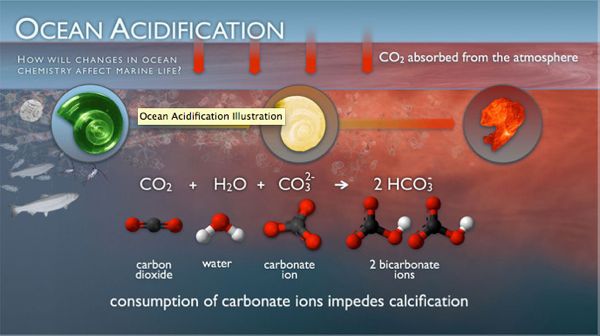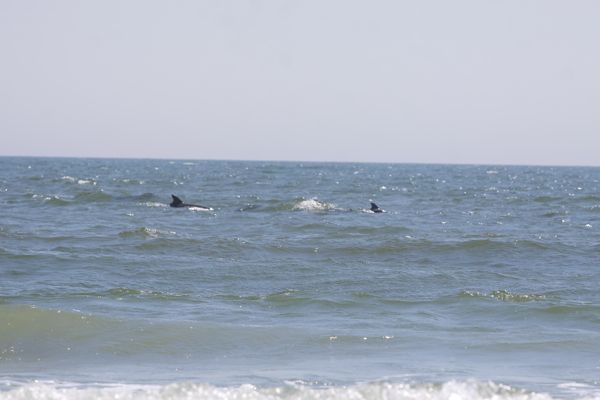Christie DEP Ignores Ocean Acidification – More Climate Denial
Climate Induced Warming & Acidification, Pollution, & Overfishing Threaten Collapse of Ocean Ecosystems
DEP Has No Data, No Standards, No Methods, & No Interest in Developing Any of Them
[Update Below]
The regulatory wheels of clean water turn slowly at DEP and EPA, so, while this may seem like a 2 year old story, it actually is the most current information available and was just released quietly by DEP last week – i.e. there was no celebratory and self congratulatory press release by the notoriously prolific Christie DEP Press Office.
DEP finally published the EPA approved version of a key Report mandated by the federal Clean Water Act, known as the Section 305(b)/303(d) Integrated Water Quality Report.
I urge folks interested in clean water to read all the various documents which can be found here (hit this link and scroll down for all the documents).
But I want to drill down on 1 issue laid out in DEP’s response to public comments in the most recent 2012 cycle. DEP is required to respond to public comments and their responses are often quite revealing, making these response documents interesting reading.
Scientists have found that one of the potentially catastrophic effects of climate change is acidification of the oceans (See NOAA overview)
The excessive carbon dioxide in the atmosphere gets absorbed by the ocean and that decreases the pH of the ocean, a process that is having profoundly destructive effects on ocean ecosystems now, and unknown but potentially catastrophic future effects.
The Center or Biological Diversity (CBD) urged the DEP to consider the issue of acidification of the ocean. DEP is legally responsible for the health of near ocean waters.
Here is DEP’s summary of CBD’s comment:
22. Comment: Ocean acidification is an overarching threat to ocean ecosystems and fisheries that depend on a healthy environment. New Jersey should provide leadership on ocean acidification. The state has an opportunity to take steps to address this important water quality problem before it is too late. On behalf of the Center for Biological Diversity, I am writing to request that New Jersey amend its Draft 303(d) water quality assessment to: List coastal waters and Delaware Bay as threatened or impaired water bodies due to ocean acidification under Section 303(d) of the Clean Water Act. Ocean acidification is already causing measurable impacts on coastal and bay waters. The state has a duty to look at the information that is available to it to evaluate the condition of its coastal waters in the face of ocean acidification.
New Jersey should list its waters as threatened or impaired under the Clean Water Act. The available information shows that water quality has changed in excess of New Jersey’s standard due to anthropogenic inputs. Moreover, aquatic life uses are and will continue to be compromised by ocean acidification. Delaying action will only allow the problem and impacts to become more severe.
Here is DEP’s scientifically lame and incredibly bureaucratic reply – revealing a policy of denial:
Response: New Jersey’s ocean waters are classified as SC. The adopted pH criteria for SC waters is “natural conditions shall prevail.” The Department has not determined what the natural pH range should be and does not have an adequate data set to assess the condition. The Delaware Bay is classified by the Delaware River Basin Commission (DRBC). The pH criterion for Delaware Bay is 6.5-8.5. DRBC determined that 98% of the samples met the criteria in its 2012 Integrated Report. The 2% that did not meet exceeded the upper end of the criteria. The Department concurred with DRBC’s assessment and did not list Delaware Bay as impaired for pH.
In addition, the USEPA also addressed this issue in litigation settled with the Center for Biological Diversity (CBD). CBD challenged USEPA’s approval of Washington State’s 2008 303(d) List because it failed to include coastal waters as impaired for marine pH (CBD v. EPA, No. 2:09-cv- 00670-JCC (W.D.Wash.)] As a condition of the settlement agreement, USEPA issued a Memorandum of Agreement on November 15, 2010 describing how they will proceed with addressing ocean acidification in the 303(d) Program (see http://water.epa.gov/lawsregs/lawsguidance/cwa/tmdl/upload/oa_memo_nov2010.pdf).
The Memorandum, entitled: “Integrated Reporting and Listing Decisions Related to Ocean Acidification”, states:
“EPA has concluded that States should list waters not meeting water quality standards, including marine pH WQC, on their 2012 303(d) lists … using the current 303(d) listing program framework. This Memorandum does not elevate in priority the assessment of waters for OA, but simply recognizes that waters should be listed for OA when data are available. EPA recognizes that information is absent or limited for OA parameters and impacts at this point in time and, therefore, listings for OA may be absent or limited in many States … EPA will provide additional 303(d) guidance to the States when future OA research efforts provide the basis for improved monitoring and assessment methods, including approaches being developed under two significant Federal efforts … that will begin in early 2011.”
The attachment to the Memorandum includes a section on assessment of marine pH water quality criteria (WQC) as a “natural condition”. It states:
“Most states do not have detailed monitoring protocols, assessment methods, or high- resolution equipment needed to quantify natural conditions within their coastal waters, which is needed to implement such criteria. This absence is due to the fact that marine pH concentrations can vary by depth, time of day, season, and location, making it difficult to monitor accurately. Additionally, historical pH datasets typically lack the necessary detail for States to establish accurate baselines.”
Since the Department has not adopted a numeric criteria range for pH in ocean waters, an assessment method to evaluate pH in ocean waters has not been developed. EPA’s guidance does not require the states develop pH criteria for ocean waters but to list, if the measured pH exceeded the State’s adopted water quality criteria. The Department does not have sufficient data nor has the Center for Biological Diversity provided pH data collected in New Jersey’s ocean waters or Delaware Bay to support pH criteria development. Therefore, no change has been made to the 303(d) list.
DEP basically shows no concern or interest whatsoever in the issue.
DEP says that because they are not legally required to address the issue, that they will do nothing.
DEP says that because they don’t have data to characterize “natural background” (and no funds to collect this data) they can’t do anything.
But here’s the kicker: lack of data is an excuse: DEP refused to collect the data.
See no evil.
* A nasty form of climate denial.
And another example of how the KIG Open Space diversion of water resource funds was so incredibly short sighted, reckless and irresponsible.
[*which is another reason why we need a State Oceanographer].
[Update: A reader just sent me a more expansive must read story from NY Times:

